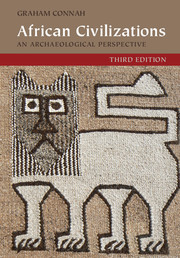Book contents
- Frontmatter
- Dedication
- Contents
- List of figures
- Preface and acknowledgements
- 1 The context
- 2 Origins: social change on the lower Nile
- 3 The Mediterranean frontier: North Africa
- 4 Sudanic genesis: Nubia
- 5 Isolation: the Ethiopian and Eritrean Highlands
- 6 Opportunity and constraint: the West African savanna
- 7 Achieving power: the West African forest and its fringes
- 8 Indian Ocean networks: the East African coast and islands
- 9 Cattle, ivory, and gold: social complexity in Zambezia
- 10 Central Africa: the Upemba Depression, Interlacustrine Region, and Far West
- 11 Settlement growth and emerging polities: South Africa
- 12 What are the common denominators?
- References
- Index
10 - Central Africa: the Upemba Depression, Interlacustrine Region, and Far West
Published online by Cambridge University Press: 05 November 2015
- Frontmatter
- Dedication
- Contents
- List of figures
- Preface and acknowledgements
- 1 The context
- 2 Origins: social change on the lower Nile
- 3 The Mediterranean frontier: North Africa
- 4 Sudanic genesis: Nubia
- 5 Isolation: the Ethiopian and Eritrean Highlands
- 6 Opportunity and constraint: the West African savanna
- 7 Achieving power: the West African forest and its fringes
- 8 Indian Ocean networks: the East African coast and islands
- 9 Cattle, ivory, and gold: social complexity in Zambezia
- 10 Central Africa: the Upemba Depression, Interlacustrine Region, and Far West
- 11 Settlement growth and emerging polities: South Africa
- 12 What are the common denominators?
- References
- Index
Summary
This book presents case studies of archaeological evidence for urbanization and state formation in precolonial Africa. The choice of areas has been dictated by the character of the archaeological evidence and by the extent of archaeological research, resulting in an incomplete picture. Not only might the individual case studies be unrepresentative of developments in the selected areas, but also there were precolonial cities and states in Africa, known from the evidence of ethnohistory or oral tradition, that are excluded. This omission is because the relevant archaeological evidence is either absent or severely limited.
The basic problem is archaeological visibility (Connah 2008). Some manifestations of early urbanization and state formation in Africa are of such a character that their archaeological investigation is peculiarly difficult. For instance, the capital city of Buganda (Gutkind 1963), a state near Lake Victoria, was described in 1889 as ‘one of the great capitals of Africa’ (Ashe 1889: 52), but it was constructed totally of grass, wood, and other organic materials and it moved frequently, particularly on the death of the Kabaka, the ruler of Buganda (Gutkind 1960: 29). The sites of these large settlements are, therefore, unlikely to have much depth of deposit or structural remains, and no archaeological investigation of them has been attempted (the last two are covered by modern Kampala). Thus there is no archaeological information about a settlement that John Hanning Speke, its first European visitor, described as ‘a magnificent sight. A whole hill was covered with gigantic huts such as I had never seen in Africa before’ (Speke 1863: 283).
There is, however, no reason why archaeologists should not be able to investigate such short-lived settlements of ephemeral materials, as was done, for example, at the South African site of Mgungundlovu (Parkington and Cronin 1979). Provided that subsequent activity or erosion has not destroyed the inevitably shallow evidence, survey and excavation techniques do exist that enable information to be obtained from sites of this type. Nevertheless, they have been seldom applied in Africa, and a lack of sophistication in research design has led to the excavation of many larger African settlement sites with structures of stone, fired brick, or mud, while sites with less substantial structural remains have been ignored.
- Type
- Chapter
- Information
- African CivilizationsAn Archaeological Perspective, pp. 299 - 329Publisher: Cambridge University PressPrint publication year: 2015



